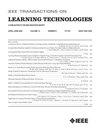Reducing English Major Students’ Writing Errors With an Automated Writing Evaluation System: Evidence From Eye-Tracking Technology
IF 2.9
3区 教育学
Q2 COMPUTER SCIENCE, INTERDISCIPLINARY APPLICATIONS
引用次数: 0
Abstract
Much research has applied automated writing evaluation (AWE) systems to English writing instruction; however, understanding how students internalize and apply this feedback to reduce writing errors is difficult, largely due to the personal and private nature of this process. Therefore, this research utilized eye-tracking technology to explore the AWE system's effectiveness in reducing the writing errors of English major students. A total of 118 higher vocational college students majoring in English in China participated in this eight-week study. The experimental group studied with and received feedback from both the AWE system (Pigai) and the teacher, whereas the control group studied without the AWE system and only received teacher feedback. Eye-tracking experiments were conducted before and after the writing instruction. Participants’ responses during the eye-tracking experiment, first-person eye movement video data, and corresponding gaze data were collected. Leveraging the application of neural network technology in optical character recognition (OCR), combined with data from an eye-tracking device, we developed a system that can transform first-person eye movement video data and gaze data into heatmaps and eye-tracking indices conducive to analysis. Various data analysis methods were employed, including neural network algorithms, heatmap analysis, Mann–Whitney U test, independent-samples用自动写作评价系统减少英语专业学生写作错误:来自眼动追踪技术的证据
许多研究将自动写作评价系统应用于英语写作教学;然而,理解学生如何内化和应用这些反馈来减少写作错误是困难的,很大程度上是由于这个过程的个人和私人性质。因此,本研究利用眼动追踪技术来探讨AWE系统在减少英语专业学生写作错误方面的有效性。共有118名中国高职英语专业的学生参加了为期8周的研究。实验组同时使用AWE系统(Pigai)和教师进行学习并获得反馈,而对照组不使用AWE系统进行学习,只接受教师反馈。在写作指导前后分别进行了眼动追踪实验。收集被试在眼动追踪实验中的反应、第一人称眼动视频数据以及相应的注视数据。利用神经网络技术在光学字符识别(OCR)中的应用,结合眼动追踪设备的数据,我们开发了一个系统,可以将第一人称眼动视频数据和凝视数据转换为热图和眼动追踪指数,便于分析。采用多种数据分析方法,包括神经网络算法、热图分析、Mann-Whitney U检验、独立样本t检验、Welch t检验等。眼动后实验反应、热图和眼动指标的结果表明,使用AWE系统的优势在于,通过对写作错误的持续反馈,促进写作错误的内化,有效提高学生识别写作错误的能力,同时减少处理时间,使学生能够将这些知识应用到新的材料中,从而更快、更准确地识别写作错误。从而帮助他们减少写作错误。对教学意义进行了充分的讨论。
本文章由计算机程序翻译,如有差异,请以英文原文为准。
求助全文
约1分钟内获得全文
求助全文
来源期刊

IEEE Transactions on Learning Technologies
COMPUTER SCIENCE, INTERDISCIPLINARY APPLICATIONS-
CiteScore
7.50
自引率
5.40%
发文量
82
审稿时长
>12 weeks
期刊介绍:
The IEEE Transactions on Learning Technologies covers all advances in learning technologies and their applications, including but not limited to the following topics: innovative online learning systems; intelligent tutors; educational games; simulation systems for education and training; collaborative learning tools; learning with mobile devices; wearable devices and interfaces for learning; personalized and adaptive learning systems; tools for formative and summative assessment; tools for learning analytics and educational data mining; ontologies for learning systems; standards and web services that support learning; authoring tools for learning materials; computer support for peer tutoring; learning via computer-mediated inquiry, field, and lab work; social learning techniques; social networks and infrastructures for learning and knowledge sharing; and creation and management of learning objects.
 求助内容:
求助内容: 应助结果提醒方式:
应助结果提醒方式:


